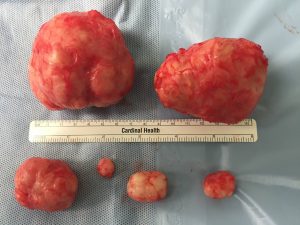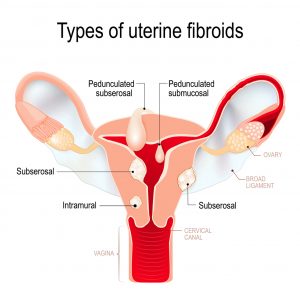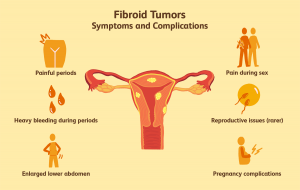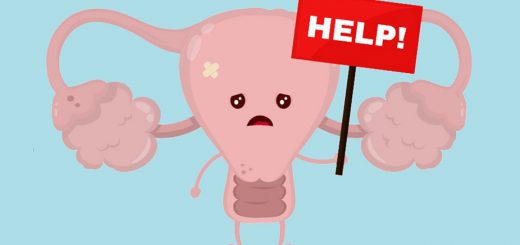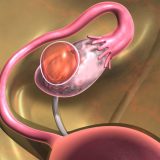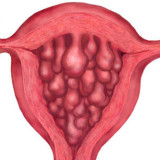Uterine fibroids or myomas are the most common type of benign tumor of the reproductive organ. This disease can occur in women of all ages. However, it is most common in late reproductive age.
Fortunately, in many cases, such a tumor does not require special treatment. It can gone itself independently, and the patient at this time just should regularly make examinations to be sure there is the positive dynamics.
Uterine fibroids – what is it?
Uterine fibroids, also called myoma uteri, are a type of benign tumor disease in the muscular layer of the uterus. They are the lumps in uterus formed from intertwining muscle fibers, which can reach large sizes.
Extremely rare, but such a tumor can degenerate into malignant, turning into leiomyosarcoma (malignant soft tissue formation).
Uterine fibroids causes
Uterine myoma are a disease whose causes are not yet fully understood.
Medical experts suspect that the formations may be triggered by hormonal disorders. Such pathological changes occur mainly in women with high levels of estrogen and at the same time low levels of progesterone.
However, there is no conclusive evidence to support the particular nature of this relationship. That is, perhaps, uterine fibroids provoke hormonal disruptions, and in consequence they develop along.
It is possible that both types of the relationships take place. And in some cases, hormonal failure is the root cause of uterine fibroids, and in other situations uterine fibroids disrupts the hormonal system.
Although there are other reasons. For example, in case of uterine fibroids we can also talk about genetic predisposition. It is noted that a woman is more vulnerable to this disease if someone in her family had the disease.
There is another pattern. Uterine fibroids are more common among women who gave birth than among those who did not give birth.
Medical professionals also mention overweight as a factor that can increase the risk of uterine fibroids. This is due to the fact that too much weight causes the release of more estrogen.
Uterine fibroids types
The tissue of uterine fibroids consists of exactly the same muscles as the walls of the uterus itself. In most women usually develop several benign tumors at the same time. They can have very different sizes, and the largest even have the size of a watermelon. However, they almost never exceed 12 cm. However, that’s still really big tumor size.
There are several types of uterine fibroids. Types of the formations can be classified in different ways.
Classification according to the number of the lumps in uterus
According to the number of the lumps in uterus, the disease can be divided into three types.
- Single. The presence of 1 or a maximum of 2 lumps. Moreover, the node(s) can be of any size.
- Multiple. The presence of 3 or more lumps in uterus. Unfortunately, even with successful treatment and reducing the severity of the symptoms, it is rarely possible to remove all the nodes.
- Mixed. The presence of several lumps in uterus, but one of them is especially large and is the main.
Classification by location and direction of growth
Submucous (submucosal) uterus fibroids
Such nodes are closer to the uterine cavity and grow in its direction. The focus is located in its mucous membrane.
Subserous fibroids
The node is located closer to the abdominal cavity and is more often on the outer surface of the uterus.
Intramural fibroids
Intramural, or interstitial uterine fibroids, can grow in the direction of the peritoneal cavity, and in the uterine cavity. The focal node is often located outside the uterus.
Cervical fibroids
The node can be located both in the wall of the uterus and its tissues, and on the surface of the organ. A feature of this type of uterine fibroids is the growth towards the vagina.
Pedunculated fibroids
These uterine fibroids grow strongly outside the body and resembles a process-a nodule “on a leg”.
Uterine fibrids symptoms
Uterine fibroids in many patients do not give any symptoms, so their detection is often completely random. However, in some cases, there may be characteristic symptoms that depend on the site of the lesion. Most often this is due to the proliferation of fibroids outside the body and pressure on adjacent tissues.
Symptoms such as:
- Abdominal pain, often in the lower part.
- Feeling pressure on the bladder or rectum.
- Intestinal obstruction.
- Painful, long and difficult periods
- Blood clots during menstruation.
- Heavy bleeding.
- Circulatory failure (manifested as weakness, headache, shortness of breath and rapid pulse).
- Premature birth.
